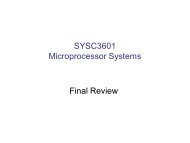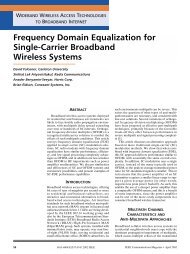Image Reconstruction for 3D Lung Imaging - Department of Systems ...
Image Reconstruction for 3D Lung Imaging - Department of Systems ...
Image Reconstruction for 3D Lung Imaging - Department of Systems ...
You also want an ePaper? Increase the reach of your titles
YUMPU automatically turns print PDFs into web optimized ePapers that Google loves.
a hyperparameter selection method, BestRes does not consider problems associated with<br />
equipment such as uncertain electrode positioning, electrode and cable problems, and electromagnetic<br />
interference (EMI) from other sources in the clinical environment. The problem<br />
<strong>of</strong> uncertain electrode positioning is mitigated primarily by using difference measurements<br />
and should not be addressed through hyperparameter adjustments. Electrode and cable<br />
errors are best addressed by detecting the problem and alerting an operator to fix it, or by<br />
compensating <strong>for</strong> the problem a posteriori through use <strong>of</strong> an algorithm such as that <strong>of</strong> [7].<br />
Excessive EMI in a clinical environment [89] will swamp the signal such that extraction <strong>of</strong><br />
in<strong>for</strong>mation is impossible regardless <strong>of</strong> hyperparameter. The BestRes method is a calibration<br />
technique to choose a hyperparameter based on a noise level that is fixed, regardless<br />
<strong>of</strong> whether the noise is representative <strong>of</strong> clinical data or added to simulated data.<br />
4.5.3 Effect <strong>of</strong> radial position on λBestRes<br />
Figure 4.10 is a plot <strong>of</strong> Resolution and λBestRes as a function <strong>of</strong> radial position <strong>of</strong> the<br />
generating contrast. These curves were generated by reconstructing a set <strong>of</strong> simulated data<br />
generated by an impulse contrast located at increasing radial positions. The best resolution<br />
is achieved <strong>for</strong> contrasts located at 75% <strong>of</strong> radial distance from the centre. Although λBestRes<br />
continues to increase as the radial position increases past 90%, the corresponding resolution<br />
starts to decrease due to blurring caused by proximity to the edge.<br />
4.5.3.1 Normalization<br />
Although primarily concerned with proportional (normalized) difference imaging we also<br />
investigated the per<strong>for</strong>mance <strong>of</strong> the Fixed NF method using simple (non-normalized) difference<br />
algorithms. The simple difference problem is solved using equation 4.2 with x defined<br />
as x = σ2 − σ1 and z defined as z = v2 − v1. (H is also modified in that its columns<br />
are not divided by vref as in section 4.2). Similar to the proportional difference algorithm<br />
the Fixed NF method was able to consistently calculate a hyperparameter located in the<br />
minimum region <strong>of</strong> the associated resolution curve.<br />
Comment on Normalization<br />
Normalization has some advantages. By normalizing the data, one does not need to know<br />
the amplitude current injected. Thus, the <strong>for</strong>ward problem can be solved using a value <strong>of</strong><br />
injected current which is convenient <strong>for</strong> the algorithm (usually ±1). The authors <strong>of</strong> [90]<br />
justify normalization with the argument that a normalized sensitivity matrix is less sensitive<br />
to the boundary shape <strong>of</strong> the object and the position <strong>of</strong> the electrodes, which is a substantial<br />
problem in clinical applications. Also, some EIT systems change the gain settings <strong>for</strong> each<br />
electrode depending on the amplitude <strong>of</strong> signal expected. Normalization can compensate<br />
<strong>for</strong> these cases as well as instances where the calibrated gain settings are not exact.<br />
Normalization <strong>of</strong> the sensitivity matrix does not change the spectrum <strong>of</strong> singular values<br />
<strong>of</strong> H T H. Although the condition number <strong>of</strong> H T H may improve by an order <strong>of</strong> magnitude<br />
or more the relative change is not significant. For the meshes used in this work the condition<br />
number <strong>of</strong> H T H improved by a factor <strong>of</strong> about 10. In other work involving non-circular<br />
meshes we have seen changes from as low as 1.5 to as high as 1000. In some cases (nonhomogenous<br />
background conductivity) the condition number increased, so it is not possible<br />
to state that, as a rule, normalization always improves the condition number <strong>of</strong> H T H.<br />
58





